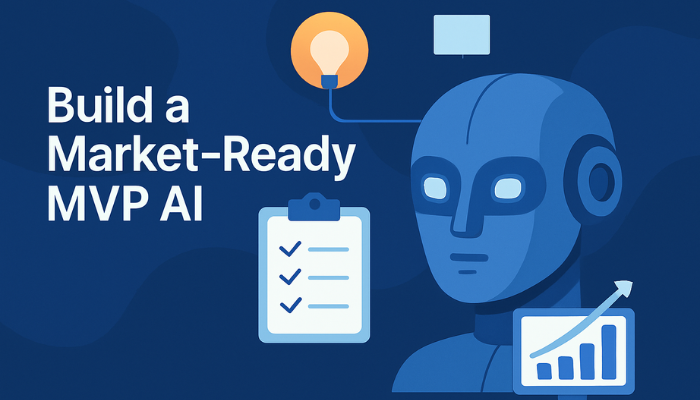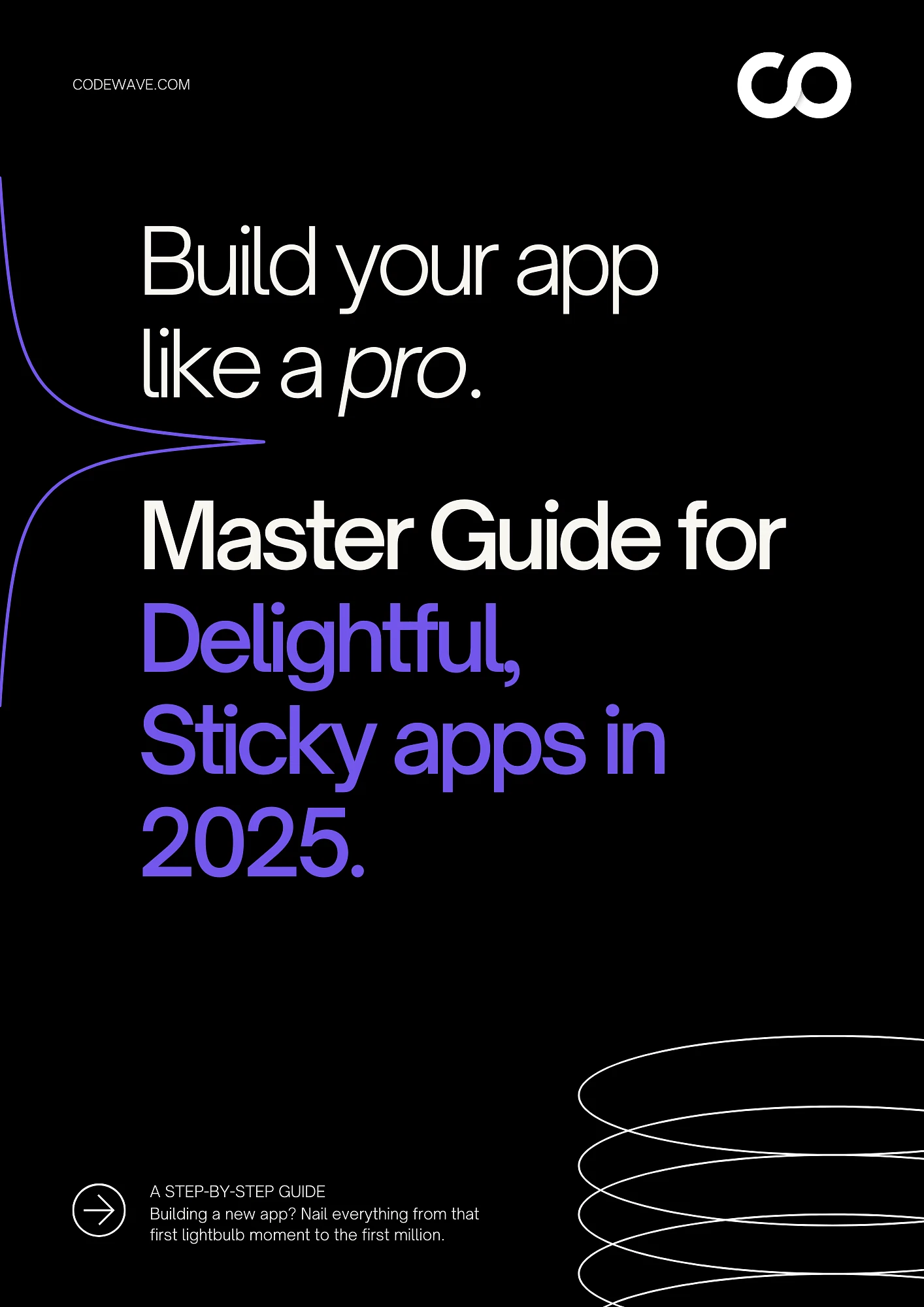“The best way to predict the future is to create it.” – Peter Drucker. And that future? It’s intelligent, adaptive, and productized through AI MVPs.
A significant 64% of businesses believe AI will boost overall productivity, according to a recent Deloitte study. But the game is evolving fast,AI MVPs are replacing generic MVPs in the modern B2B product lifecycle. These aren’t just early-stage prototypes; they’re lean, intelligent systems engineered to learn and scale from Day 1.
In today’s high-stakes market, validating an idea isn’t enough. You need a system that can act, adapt, and optimize in real time. That’s what makes an AI MVP a strategic imperative, not just for startups, but for enterprises building long-term value.
This blog lays out practical, results-driven strategies to build AI MVPs that deliver measurable ROI. From lean architecture to real-world feedback loops, you’ll get a playbook built for speed, relevance, and impact, so you can lead, not lag, in your industry.
Understanding AI MVP: A Hybrid Model Built for Market Testing
You’ve probably heard of a “Minimum Viable Product”, something quick, basic, and just enough to test an idea. But when you layer artificial intelligence into that equation, the outcome is no longer just minimal. It’s smart. It adapts. And it’s designed to grow sharper with every click, query, or tap.
So what exactly is an AI MVP?
In simple terms, it’s a lean version of your product, with AI baked in from Day 1, to help you validate your idea, collect real usage data, and improve based on user behavior. But here’s what sets it apart from a regular MVP:
- Predictive capabilities: AI helps your product understand user patterns and act ahead of time. Instead of just responding, it proactively supports the user’s next move.
Example: In a digital banking MVP, AI can suggest payment reminders or personalized financial tips before the user even asks.
- Faster feedback loops: AI tracks how users interact with your product and picks up patterns automatically. This removes the need for waiting on surveys or manual feedback.
Example: In a B2B sales tool, the AI can detect which features sales teams use most and suggest changes without a single feedback form.
- Built-in learning: An AI MVP keeps learning in the background and adjusts features accordingly. You don’t need to manually push updates to stay relevant.
Example: In a healthcare app MVP, AI can adjust how it displays appointment slots or reminders based on patient habits over time.
- Cost-effective scalability: AI allows your MVP to deliver custom experiences tailored to each user, even if you’re targeting different buyer personas.
Example: In an e-learning MVP, AI can show different course paths based on how quickly or slowly a user is progressing.
- Higher personalization: An AI MVP is built with flexibility. When your product starts scaling, AI helps the system handle more users and more data without rework.
Example: In a logistics MVP, as orders increase, AI can optimize delivery routes automatically without changing the core system.
Also read: What is MVP in Software Development?- Complete Guide
Let’s be honest: today’s market doesn’t have the patience for “basic.” If your MVP isn’t intelligent, it’s irrelevant. Building with AI from the start isn’t just innovative, it’s expected.
Strategies to Launch an AI MVP That Delivers Real Value
Most AI MVPs fail not because of tech, but because they skip strategy. Your AI MVP shouldn’t just function, it should validate one core business outcome in the shortest time possible.
1. Validate Problem-Solution Fit Using Smart Discovery
A successful AI MVP isn’t built on assumptions. It starts with knowing exactly what to solve, and for whom. This means moving past shallow market research and digging into user behavior.
1. Listen to Real Complaints
Look at what users say publicly, especially when they’re frustrated. Online platforms often show you what isn’t working.
Example: If users on Reddit or G2 are complaining about confusing dashboards in existing tools, that’s a clear signal your product can simplify reporting.
2. Group Similar Pain Points
If multiple users are frustrated by the same issue, it’s worth solving. Don’t try to fix everything, fix what’s common and painful.
Example: You might see repeated mentions of slow customer support in a tool. That’s your chance to build an AI-powered assistant into your MVP.
3. Watch for Workarounds
If users are stitching together tools or spreadsheets just to get something done, it shows there’s a clear gap in the market.
Example: If people are using Excel to manage team performance because existing tools are too rigid, you can build an AI MVP that auto-generates performance summaries.
4. Study Early-Stage Competitors
Look at other MVPs in your space. See what they’re missing or doing poorly, and use that as your entry point.
Example: A competitor’s AI chatbot might give generic answers. Your AI MVP can focus on tailoring responses based on user profile and behavior.
This approach ensures you’re not investing in building just another product; you’re solving real, urgent problems that others are failing to address. That’s how an AI MVP earns traction fast.
2. Set Clear Success Criteria from Day 1
You can’t scale what you can’t measure. Your AI MVP needs success criteria that go beyond vanity metrics and reflect its real contribution to user and business outcomes. The clearer you are, the faster you’ll know if your AI is market-fit, or just hype.
Prioritize these high-signal metrics:
1. Check If AI Is Giving the Right Output
Make sure the AI does what users expect, like giving accurate recommendations or helpful summaries.
Example: If you’re building a hiring assistant, it should suggest candidates that match what recruiters are looking for, not random profiles.
2. See If AI Nudges Lead to Action
Track if AI-driven suggestions actually influence user behavior; like clicking, signing up, or buying.
Example: An AI pricing tool suggests discounts. You check if customers actually respond and complete purchases more often.
3. Watch Which Features Users Try First
Focus on how quickly users start using the AI-driven parts of your product. It’s a sign of real interest or value.
Example: If your AI tool includes automated invoice approvals, but no one uses it in the first week, it’s a red flag.
4. Check If People Stick Around
The AI should help users stay longer and keep coming back. If they leave, it means the experience isn’t meaningful enough.
Example: A CFO dashboard that predicts cash flow issues should make finance teams check it regularly, not ignore it.
5. See If AI Saves Time
Ask whether the AI is cutting down manual work or decision time. That’s a clear business win.
Example: If your AI sorts support tickets, support agents should be resolving issues faster, not spending more time reviewing them.
These simple checks tell you fast if your AI MVP is solving a real problem, or just adding noise. It keeps your team focused and helps you avoid wasting budget on features that don’t matter.
3. Build with Lean, Train with Precision
When you’re building an AI MVP, size doesn’t equal strength, clarity does. You want a model that proves value quickly without draining your time, budget, or compute.
1. Test with Simulated Data First
If you don’t have access to real user data in the early stage, create examples that mimic real scenarios. This helps you check if your AI behaves as expected before launch.
Example: You’re building an AI to flag suspicious claims. Start by feeding it mock claims with known issues, and see if it catches them.
2. Use Pre-Trained Models to Save Time
You don’t need to build your AI from scratch. Start with a model that’s already trained and just tweak it for your use case.
Example: Use an open-source language model to write customer responses, then adjust it slightly to match your company’s tone and rules.
3. Add Your Data to Make It Relevant
Generic AI doesn’t help much. You need to feed it data from your domain; support chats, invoices, and logs, so it learns what’s relevant to your users.
Example: A recruitment tool becomes smarter when you train it on your past hiring decisions, not just public job data.
You’re not trying to build the smartest AI, you’re trying to build the right one. When you start small and train it with focused input, you avoid over-engineering and reach usable results faster.
4. Stack Smart: Build on Scalable, Maintainable Architecture
When building your AI MVP, setting up the right architecture early on saves you major headaches later. You want flexibility, speed, and scalability. Here’s how to achieve that:
1. Use Pre-built AI Tools for Faster Development
Leverage frameworks like LangChain, PyTorch, and HuggingFace to quickly implement AI capabilities. These frameworks provide pre-built models, so you don’t have to start from scratch. This allows you to focus on customizing the model to your specific needs, cutting down on development time.
Example: With PyTorch, you can quickly prototype a recommendation engine that learns from user behavior without spending weeks developing basic neural networks. This speeds up your development process, allowing you to launch your MVP faster and start gathering real-world user data sooner.
2. Make Features Easy to Add or Change
Opt for modular APIs and plug-ins. APIs let you integrate new functionality without disrupting your MVP’s core features, allowing you to test and iterate on new ideas quickly.
Example: If you initially launch an AI-driven chatbot with a basic set of responses, you can later add advanced conversational AI by plugging in Dialogflow or another natural language processing API. This allows you to easily upgrade your AI’s capabilities based on user feedback without needing to rewrite your entire system.
3. Automate Workflow for Faster Iterations
Using Docker for containerization and CI/CD pipelines (like Jenkins or GitLab CI) ensures consistency across different stages of development. Docker creates a consistent environment across all systems, while CI/CD automates code testing and deployment, allowing for continuous updates and faster feedback.
Example: With Docker, you can run your AI model consistently across various environments, so whether it’s being tested on your local machine or deployed in the cloud, the performance remains the same. Additionally, CI/CD pipelines mean that each code change is automatically tested and deployed, which helps you fix bugs and push updates faster.
Building with these tools gives you a smooth path from prototype to product, all while staying nimble and adaptable as you learn what works and what doesn’t. Keep your tech stack light but powerful, this makes it easier to scale and maintain.
5. Prioritize UX-First AI Design
The success of your AI MVP depends heavily on how your users interact with it. A well-designed user interface (UI) can make a huge difference in how they perceive the AI’s value and usability.
1. Make the Interface Simple
Keep your AI’s interface clean and easy to use. Avoid showing technical complexity, users should get results without needing to know how it works.
Example: Instead of showing confidence scores, display a simple message like “Recommended for You” or “Next Best Action.”
2. Show Why the AI Made a Decision
Use visual cues or short messages to explain AI decisions. This builds trust, especially in high-stakes or B2B use cases.
Example: If the AI suggests a pricing change, add a short note like “Based on past 6 months of sales data.”
3. Collect Feedback Inside the App
Let users give quick feedback on AI suggestions, like a thumbs up/down or a short comment box. Use this to improve accuracy and experience over time.
Example: After a suggestion, add: “Was this helpful?” with one-click options.
Good UX drives adoption. It turns a smart algorithm into a tool people trust and use daily, without training or hand-holding.
6. Mitigate AI MVP Pitfalls Early
To ensure your AI MVP is robust and scalable, address key challenges from the start:
1. Address Bias Early
AI systems can unintentionally favor one group over another, leading to unfair or inaccurate results. To avoid this, test your AI using a variety of data sources and edge cases, ensuring it works across all demographics and situations.
Example: Before launching, test the AI with diverse customer data, different ages, locations, and backgrounds, to identify any unintended bias in recommendations.
2. Ensure Privacy Compliance
Data protection is non-negotiable. From Day 1, implement privacy measures that ensure compliance with regulations like GDPR and CCPA. Focus on anonymizing sensitive data, only collecting essential information, and getting clear user consent.
Example: Add clear consent pop-ups during sign-up, informing users how their data will be used, and only collect what’s necessary for the AI to function.
3. Manage Costs Effectively
AI can be resource-intensive, but you can minimize costs by using flexible cloud services instead of building your own infrastructure. This way, you can scale as needed and avoid overspending while refining the AI model.
Example: Use platforms like AWS or Google Cloud to rent computing power instead of buying expensive servers. This allows you to scale up or down based on project needs.
Before scaling AI, top leaders test fast. Here’s why MVPs are their smartest first move.
Why Strategic Leaders Choose AI MVPs
An AI MVP isn’t just a quick test, it’s a way to prove your ideas work before making a big commitment. It gives you confidence, helps you focus your resources, and shows the potential value of AI at a smaller scale. Here’s why top business leaders are betting on AI MVPs first:
1. Accelerated Time-to-Value
CEOs want speed without chaos. MVPs reduce time-to-market from quarters to weeks, allowing you to test core AI value propositions early, before your competitors even finish their proof of concept phase. The result? Quicker validation and faster strategic momentum.
2. Controlled Capital Exposure
Building full-scale AI systems can require a huge upfront investment with uncertain returns. An MVP limits your spending while providing clear insights into what works and what doesn’t. This allows you to focus your budget only on ideas that have been proven to work.
3. Strategic Data Activation
AI MVPs help you understand which data is useful, which is missing, and how to organize it better. This way, you avoid wasting time on unnecessary data and build a foundation that can be used to drive real outcomes for your business..
4. Tangible Proof for Stakeholders
AI MVPs deliver measurable results, like improved sales, faster processing times, or better predictions. This makes it easy to show your team and investors that AI is delivering value from day one, helping everyone stay aligned and focused on what works.
5. Reduced Technical Debt
Instead of committing to complex systems that could become outdated, MVPs allow you to start with simpler, scalable technology that grows with your needs. This reduces the risk of having to make costly changes down the line.
6. AI Governance From Day 1
AI MVPs include important safeguards from the start, ensuring that your projects are meeting necessary legal and ethical standards. This saves time and money by avoiding issues that might arise later in the process.
Bold decisions need careful planning. Let’s explore how businesses can get the most out of AI without the common pitfalls.
Execution Challenges (And How Strategic Teams Solve Them)
Even after a strong kickoff, AI MVPs often lose momentum halfway through. Strategic misfires, team silos, and premature scaling can kill promising pilots. Let’s break down what typically goes wrong and how experienced teams course-correct before it’s too late.
1. Misalignment Between Tech and Business Goals
Engineering teams often optimize for technical metrics like model accuracy or F1 scores, while leadership expects tangible business outcomes; cost reduction, efficiency, or customer satisfaction.
Why does this happen?
Teams start building without aligning on shared KPIs. Engineers default to what’s measurable on their end, while business teams assume value will “naturally” follow once the model works.
How do strategic teams fix it?
They define business-linked success metrics upfront—e.g., “reduce manual review time by 40%”, and make them visible to all teams. Product managers track these metrics through dashboards that report both model and business performance in real time.
2. Model Works in Lab, Fails in Production
An AI model that works well in test environments often collapses in the wild, failing to handle noisy inputs, edge cases, or shifting data patterns.
Why does this happen?
Test environments are too sanitized. Developers train and validate on curated datasets that don’t reflect real-world unpredictability, leading to overconfidence in performance.
How do strategic teams fix it?
They deploy models in shadow mode or through A/B testing early in the lifecycle. This exposes weaknesses and variability. By continuously logging edge cases and retraining with real-world inputs, they fine-tune the system before full-scale rollout.
3. Feedback Loops Get Ignored
User feedback often never reaches the model development loop. This stalls learning and leaves poor predictions unresolved.
Why does this happen?
Feedback loops are either missing or disconnected; UX captures issues, but there’s no mechanism to feed this data into the ML pipeline. It’s treated as support noise rather than model fuel.
How do strategic teams fix it?
They design UX components that allow users to flag poor outputs in-product. This data is automatically routed to the model team and integrated into retraining pipelines, closing the loop and enabling continuous improvement.
4. Overfitting to Initial Use Case
Initial success often creates a trap, models become tightly coupled to one use case, making it difficult to extend or repurpose.
Why does this happen?
Teams optimize for speed and hard-code workflows without abstraction. Flexibility is sacrificed for immediate gains, leaving the system brittle when business needs shift.
How do strategic teams fix it?
They invest in modular architecture from Day 1; separating pipelines, model logic, and interface layers. This allows the MVP to grow into a platform with minimal friction or technical debt.
5. Team Bandwidth Bottlenecks
As fire drills mount, ML, product, and backend teams get stretched thin, impacting delivery timelines and model quality.
Why does this happen?
Teams juggle manual workflows like retraining, monitoring, and deployment while also trying to build new features. No clear owner is driving MVP velocity.
How do strategic teams fix it?
They automate MLOps, scheduling retraining, monitoring for drift, and managing releases. A single PM is assigned to drive ownership of the MVP, streamline decisions, and shield teams from distractions.
6. Overengineering Too Soon
Teams often overbuild infrastructure and UI before validating user interest, wasting time and resources.
Why does this happen?
There’s pressure to ship something “impressive,” so teams design for scale and complexity before confirming that the core function delivers value.
How do strategic teams fix it?
They ship lean. The MVP includes only the core functionality needed to test hypotheses. Infrastructure and UX scale only once usage patterns justify further investment, keeping scope aligned with actual demand.
Why Codewave Is a Strategic Partner for AI MVP
At Codewave, we don’t just build AI MVPs, shape experiences that work in the real world. Our design-led approach ensures your product isn’t just technically sound but also intuitive, scalable, and market-ready. From ideation to launch, we handle the entire stack, so you can focus on solving the right problem.
What Codewave Brings to Your AI MVP:
We build purpose-driven AI models trained on relevant datasets, optimized for accuracy, speed, and bias mitigation from Day 1.
Your MVP runs on scalable, secure, and cost-efficient cloud environments. We architect for future growth, not just launch.
Whether it’s a fast backend or a sleek front-end, our engineers use proven frameworks to ship robust, responsive apps.
From smart assistants to automated workflows, we bring GenAI into business ops, reducing manual work and increasing output efficiency.
Our team designs frictionless interfaces backed by real user insights, and tests rigorously to ensure a bug-free launch.
- Rapid Prototyping → Product-Market Fit
We prototype fast, validate early, and adapt quickly, so your AI MVP solves the right problem before scaling up.
Want a no-risk discovery call on building your AI MVP? Connect with Codewave for a tailored blueprint.
Final Say
In the AI era, MVPs aren’t just minimal, they’re exponential.
The faster you launch a working AI MVP, the quicker you learn what matters. Real feedback, not assumptions, drives product success. Waiting to perfect it only delays your growth.
A strong MVP doesn’t aim for completeness, it proves your AI delivers value. Whether it’s improving workflows or solving a specific user pain point, your AI MVP should earn trust from day one.
Build something functional, testable, and usable. Then improve it fast. Partner with a team that knows how to get AI MVPs to market; fast and right. Build your next-gen AI MVP with Codewave.
Codewave is a UX first design thinking & digital transformation services company, designing & engineering innovative mobile apps, cloud, & edge solutions.







